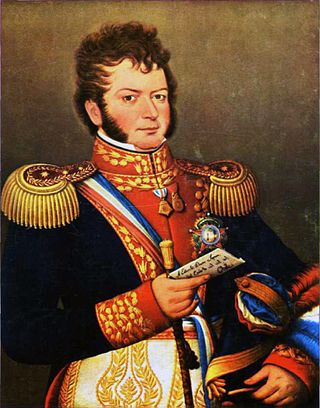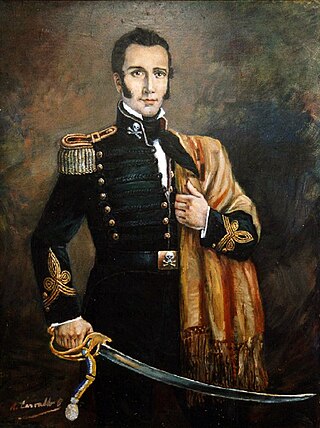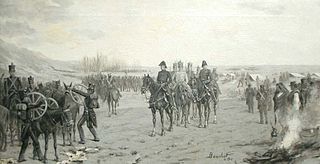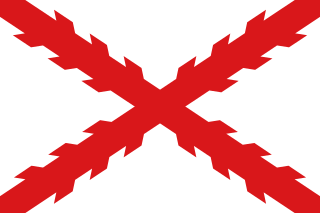
Bernardo O'Higgins Riquelme was a Chilean independence leader who freed Chile from Spanish rule in the Chilean War of Independence. He was a wealthy landowner of Basque-Spanish and Irish ancestry. Although he was the second Supreme Director of Chile (1817–1823), he is considered one of Chile's founding fathers, as he was the first holder of this title to head a fully independent Chilean state.

José Francisco de San Martín y Matorras, nicknamed "the Liberator of Argentina, Chile and Peru", was an Argentine general and the primary leader of the southern and central parts of South America's successful struggle for independence from the Spanish Empire who served as the Protector of Peru. Born in Yapeyú, Corrientes, in modern-day Argentina, he left the Viceroyalty of the Río de la Plata at the early age of seven to study in Málaga, Spain.

The Carrera family of Chile became politically influential during the colonial period and played a significant role in the Chilean independence. They remained politically important throughout the 19th century.

José Miguel Carrera Verdugo was a Chilean general, formerly Spanish military, member of the prominent Carrera family, and considered one of the founders of independent Chile. Carrera was the most important leader of the Chilean War of Independence during the period of the Patria Vieja. After the Spanish "Reconquista de Chile" ("Reconquest"), he continued campaigning from exile after defeat. His opposition to the leaders of independent Argentina and Chile, San Martín and O'Higgins respectively, made him live in exile in Montevideo. From Montevideo Carrera traveled to Argentina where he joined the struggle against the unitarians. Carreras' small army was eventually left isolated in the Province of Buenos Aires from the other federalist forces. In this difficult situation Carrera decided to cross to native-controlled lands all the way to Chile to once and for all overthrow Chilean Supreme Director O'Higgins. His passage to Chile, which was his ultimate goal, was opposed by Argentine politicians and he engaged together with indigenous tribes, among them the Ranquel, in a campaign against the southern provinces of Argentina. After the downfall of Carrera's ally, the Republic of Entre Ríos, and several victories against the United Provinces of the Río de la Plata, Carrera's men were finally defeated by numerically superior forces near Mendoza. Carrera was then betrayed by one of his Argentine helpers, leading to his capture and execution in that city.

The Argentine War of Independence was a secessionist civil war fought from 1810 to 1818 by Argentine patriotic forces under Manuel Belgrano, Juan José Castelli, Martin Miguel de Guemes and José de San Martín against royalist forces loyal to the Spanish crown. On July 9, 1816, an assembly met in San Miguel de Tucumán, declaring independence with provisions for a national constitution.

Manuel Xavier Rodríguez Erdoíza was a Chilean lawyer and guerrilla leader, considered one of the founders of independent Chile. Rodríguez was of Basque descent.

The Chilean War of Independence was a military and political event that allowed the emancipation of Chile from the Spanish Monarchy, ending the colonial period and initiating the formation of an independent republic.

The Crossing of the Andes was one of the most important feats in the Argentine and Chilean wars of independence. A combined army of Argentine soldiers and Chilean exiles crossed the Andes mountains, which separate Argentina from Chile, to invade Chile, leading to its liberation from Spanish rule.

Mateo de Toro Zambrano y Ureta, 1st Count of La Conquista, was a prominent Spanish military and political figure of Criollo descent. He held the position of a knight in the Order of Santiago and was the lord of the Toro-Zambrano estate.

Francisco Casimiro Marcó del Pont y Ángel was a Spanish soldier and the last Governor of Chile. He was one of the main figures of the Chilean independence process, being the final Spaniard to rule as Royal Governor of Chile from 1815 to 1817, when he was deposed and captured by the patriot forces after the Battle of Chacabuco.

The Army of the Andes was a military force created by the United Provinces of the Río de la Plata (Argentina) and assembled by General José de San Martín as part of his campaign to liberate Chile from the Spanish Empire. In 1817, it crossed the Andes Mountains from the Argentine province of Cuyo and succeeded in its objective by driving the Spanish out of Chile.

Grand Marshal Juan Gregorio de las Heras was an Argentine soldier who took part in the Spanish American wars of independence and was also a governor of the province of Buenos Aires.

Brigadier Juan Mackenna was an Irish-born, Chilean military officer and hero of the Chilean War of Independence. He is considered to have been the creator of the Corps of Military Engineers of the Chilean Army.

Colonel Luis Florentino Juan Manuel Silvestre de los Dolores de la Carrera y Verdugo was a Chilean military officer who fought in the Chilean War of Independence. Together with his brothers José Miguel and Juan José, they were some of most important leaders of Chilean struggle for independence during the period of the Patria Vieja. The Carrera family is of Basque origin.

Ignacio de la Carrera y Cuevas (1747–1819) was a Chilean aristocrat, member of the First Government Junta of Chile, and father of the Carrera brothers, who were some of the most important leaders of the early Chilean struggles for independence during the period of the Patria Vieja. Ignacio de la Carrera was of Basque descent.

María Mercedes Fontecilla y Fernández de Valdivieso was a First Lady of Chile for less than two months in 1814 through her marriage to José Miguel Carrera.

Friar José Camilo Henríquez González was a priest, author, politician, and is considered an intellectual antecedent to and founding father of the Republic of Chile for his passionate leadership and influential writings. He was also one of the most important early South American newspaper writers and wrote several essays, most notably the Proclama de Quirino Lemachez, which promoted Chilean independence and liberty. He also wrote under the pseudonym Quirino Lemachez.

Spanish Reconquest or just Reconquest is the name of a period of Chilean history that started in 1814 with the royalist victory at the Battle of Rancagua and ended in 1817 with the patriot victory at the Battle of Chacabuco. During this period, the defenders of the Spanish Empire reestablished their dominion in Chile after said country had separated itself from the Spanish Crown, installed its First National Government Board in 1810—the first institution of self-government in Chile, created its First Congress National in 1811 and subsequently elected its first supreme director, Francisco de la Lastra, in 1814.
The Battle of Les Tres Acequias, fought during the Chilean War of Independence, occurred near San Bernardo on 26 August 1814. The confrontation occurred between the two factions of Carrera and Bernardo O'Higgins, resulting in a defeat for O'Higgins that would in turn lead on to the defeat of the nationalists by the royalist forces at the battle of Rancagua a month later.

Juan José Pedro de la Carrera y Verdugo or Juan José Pedro Carrera was a Chilean soldier and patriot who actively participated in the first phase of the Chilean War of Independence, a stage known as the Patria Vieja. In support for his brother José Miguel Carrera, and together with his younger brother Luis and other Republican officers, he formed one of the main factions within the supporters of Independence: the Carrerino group. He was shot to death in Mendoza together with his brother Luis, at the hands of the city authorities.























